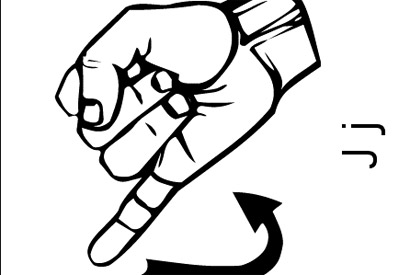ASL language courses a sign of the times at Berkeley
Renowned for the range of languages it offers — everything from Aramaic and Breton to Urdu and Yiddish — UC Berkeley has just added introductory courses in American Sign Language. Students are enthusiastic about the ASL offerings, taught by an accomplished scholar and linguist, as are disability-studies advocates and members of the deaf community.

September 20, 2012
Unlike many of his peers, lecturer Patrick Boudreault never worries whether his students are Web surfing, or otherwise distracted, on their digital devices. As he holds forth in front of his quiet classroom — explaining a concept, fielding a question — all eyes are upon him, intent on his every gesture and facial expression. When he cracks a joke, which is often, laughter breaks through the silence.
Students know they have to stay focused on their tall, animated prof if they want to pass this course. An accomplished scholar and linguist, deaf from birth, Boudreault teaches American Sign Language, and does so almost exclusively in sign. “No English,” he emphasizes in a phone interview relayed by an ASL-English interpreter. “We learn how to present an idea in a visual manner, how to use space, how to find patterns in language.”
The American Sign Language listings in the fall 2012 course catalog are a first for UC Berkeley. Although renowned for the number and range of languages taught here — everything from Aramaic and Breton to Urdu and Yiddish — the campus, until now, has not offered ASL during the regular academic year, says Susan Schweik, associate dean in the arts and humanities division of the College of Letters and Science. In the past, students interested in sign had to look to Berkeley City College (formerly Vista College), or take a summer class or a student-run DeCal course.
The language, however, is in increasing demand at campuses across the country. In a recent survey by the Modern Languages Association, in fact, ASL ranked as the fourth most-studied language in higher education.
Online video has helped pique popular interest in ASL, notes Schweik. On YouTube you’ll find not only ASL lessons but IRS tax tips in ASL, handshape rhymes and sign for babies and toddlers.
Passionate about language
As a deaf person in a hearing world, “I am bound to negotiate in the realm of non-verbal communication,” says multilingual scholar and teacher Patrick Boudreault. “I’m adept at communication with anyone, every day of my life — people who know sign or don’t know sign.”

Born deaf to deaf parents, Boudreault’s first languages were Quebec Sign Language, then French, which he learned to read and write as a child. He added English and American Sign Language to his repertoire in his early teens. In introducing himself to students, he adds that he’s married to a Russian woman whose native languages are Russian and Russian Sign Language. (His wife, Genie Gertz, is dean of deaf studies at Ohlone College, in Fremont.)
“That’s six languages in my home,” he says. “It makes me passionate about language and linguistics.”
Boudreault earned a B.A. in linguistics from Université du Québec à Montréal, a master’s in communication sciences and disorders from McGill University and a Ph.D. in educational psychology from the University of Manitoba.
A passionate advocate for the deaf community, he chairs the bioethics committee of the National Association of the Deaf and has researched widely in his field. Currently, he is co-principal investigator of a study, funded by the National Institutes of Health, on developing genetic-education materials for the deaf community.
A travel enthusiast, Boudreault is keenly interested in exploring foreign cultures and languages and meeting other deaf people. He’s also a cyclist, regularly mountain biking in the Bay Area and the Sierra with a group of deaf riders.
Meanwhile, hearing academics like Berkeley linguistics expert Eve Sweetser and scholars from the deaf community have been steadily building the case for ASL and deaf culture as complex subjects meriting scholarly attention. Beginning in the late 19th century, notes Boudreault, signed language was oppressed in many places, only gaining ground in recent decades. Today, ASL is no longer seen merely as gesture or “the equivalent of social dancing,” says Schweik, a longtime disability-studies advocate. Instead, she says, it’s increasingly regarded as a “serious language with its own complex forms and rules” — one that uses space, rather than sound, to build meaning.
“People are fascinated that they can learn a language that is not based on sound,” notes Boudreault, who has taught ASL and Quebec Sign Language (LSQ) in the U.S. and Canada for 20 years. Some imagine that ASL is “going to be a piece of cake, an easy A,” he says — but they quickly discover “how complex it really is.”
If any of his Berkeley students shared that misconception, they kept it to themselves during the first class session in late August — the one time that interpreters were on hand, to lay out the course and facilitate introductions all around. Describing herself as “really bad at learning languages,” one student said she hoped ASL “would engage a different part of my brain.” Another had recently read Oliver Sachs’ Seeing Voices — described as “a journey into the world of deaf culture” — and was fascinated by its portrayal of ASL. A third had a serious hearing impairment, while a fourth hoped to communicate with a deaf aunt.
The addition of ASL courses to the foreign-language curriculum — albeit on a trial basis, with special funding from the campus’s Common Good Initiative — is a long-overdue and “incredibly important” development for Berkeley, Schweik contends. “In my dreams this is a first step,” she says, toward a deaf-studies curriculum that includes ASL.
Excitement extends to the Bay Area’s large deaf community, where many are “immensely thrilled to know that our language is recognized by a high-ranking university,” reports Boudreault. “This will only enhance respect for the language…. This can be considered a milestone.”